Themed collection Spotlight Collection: Photoinduced redox chemistry

Spotlight collection on photoinduced redox chemistry
Guest Editors Paul I. Elliott, Katja Heinze and Thomas Teets introduce the spotlight collection, “Photoinduced redox chemistry”.

Dalton Trans., 2023,52, 9186-9188
https://doi.org/10.1039/D3DT90112B
The role of photoinduced charge transfer for photocatalysis, photoelectrocatalysis and luminescence sensing in metal–organic frameworks
Understanding PCT taking place within MOFs is crucial for designing porous photo/electrocatalysts and luminescent sensors. Unique features of PCT in MOFs and recent progress along with state-of-the-art characterization methods are discussed in the context of its applications.

Dalton Trans., 2020,49, 12892-12917
https://doi.org/10.1039/D0DT02143A
Photo-generation of H2 by heterometallic complexes
This review focuses on the latest findings on the photochemical production of H2 catalyzed by heterometallic complexes.

Dalton Trans., 2022,51, 14022-14031
https://doi.org/10.1039/D2DT01870E
[Re(CO)3(5-PAN)Cl], a rhenium(I) naphthalimide complex for the visible light photocatalytic reduction of CO2
A rhenium(I) naphthalimide complex [Re(CO)3(5-PAN)Cl] (Re(5-PAN); 5-PAN = 1-(1,10-phenanthroline)-4-nitro-naphthalimide) was synthesized, characterized, and evaluated as a photocatalyst for CO2 reduction.
![Graphical abstract: [Re(CO)3(5-PAN)Cl], a rhenium(i) naphthalimide complex for the visible light photocatalytic reduction of CO2](/en/Image/Get?imageInfo.ImageType=GA&imageInfo.ImageIdentifier.ManuscriptID=D0DT04116E&imageInfo.ImageIdentifier.Year=2021)
Dalton Trans., 2021,50, 3479-3486
https://doi.org/10.1039/D0DT04116E
Mapping the influence of ligand electronics on the spectroscopic and 1O2 sensitization characteristics of Pd(II) biladiene complexes bearing phenyl–alkynyl groups at the 2- and 18-positions
Extension of biladiene complexes via introduction of phenyl-alkynyl groups at the 2- and 18-positions generates new platforms that efficiently sensitize formation of 1O2 using long-visible light.

Dalton Trans., 2023,52, 7512-7523
https://doi.org/10.1039/D3DT00691C
Evaluating the photophysical and photochemical characteristics of green-emitting cerium(III) mono-cyclooctatetraenide complexes
The photophysical properties and photochemical reactivity of the organometallic mono(cyclooctatetraenide)-Ce(III) complexes: [(C8H8)Ce(μ-X)(THF)2]2 X = O3SCF3− (1), Cl− (2), were studied.

Dalton Trans., 2023,52, 5909-5917
https://doi.org/10.1039/D3DT00351E
Excited state processes of dinuclear Pt(II) complexes bridged by 8-hydroxyquinoline
Two novel dinuclear Pt(II) complexes featuring 8-hydroxyquinoline bridges were synthesized and found to have photophysical properties dominated by ligand-centered transitions mirroring that of a mononuclear model system, [Pt(8HQ)2].

Dalton Trans., 2023,52, 4008-4016
https://doi.org/10.1039/D3DT00348E
Mechanistic insights into template-driven polyoxovanadate self-assembly: the role of internal and external templates
Insights into the template-induced self-assembly of dodecanuclear polyoxovanadate host–guest complexes is provided by solution and solid-state methods.
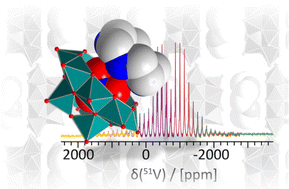
Dalton Trans., 2023,52, 4002-4007
https://doi.org/10.1039/D3DT00252G
Synthesis, photophysical characterization, and aerobic redox reactivity of electron-rich tellurorhodamine photocatalysts
A series of tellurorhodamine dyes photocatalytically oxidize silanes to silanols with visible light, oxygen, and water with substituent dependent rates.

Dalton Trans., 2023,52, 3990-4001
https://doi.org/10.1039/D2DT03534K
Visible light induced formation of a tungsten hydride complex
The bond cleavage of [CpW(CO)3]2 with blue light in the presence of acid leads to disproportionation followed by fast protonation. Quantum yield measurements indicate disproportionation occurs through a radical chain mechanism.

Dalton Trans., 2023,52, 3210-3218
https://doi.org/10.1039/D2DT03675D
Photodynamic therapy with mitochondria-targeted biscyclometallated Ir(III) complexes. Multi-action mechanism and strong influence of the cyclometallating ligand
Four Ir(III) complexes have been synthesized as photosensitizers for PDT. Derivatives bearing 2-phenylpyridinate exhibit high photocytotoxicity through a mitochondria-targeted mechanism involving NADH oxidation, membrane depolarization and DNA damage.

Dalton Trans., 2022,51, 111-128
https://doi.org/10.1039/D1DT03080A
Dinuclear 2,4-di(pyridin-2-yl)-pyrimidine based ruthenium photosensitizers for hydrogen photo-evolution under red light
We investigate the impact of multiple metal centers in ruthenium(II) photosensitizers for hydrogen evolution experiments.

Dalton Trans., 2021,50, 16528-16538
https://doi.org/10.1039/D1DT00868D
Photoinduced electron transfer in non-covalent complexes of C60 and phosphangulene oxide derivatives
Investigation of photoinduced electron transfer (PET) in complexes of fullerene with phosphangulene oxides shows that the replacement of O atoms in with S atoms in phosphangulene promotes efficient and ultrafast ET from phosphangulene oxide to fullerene.
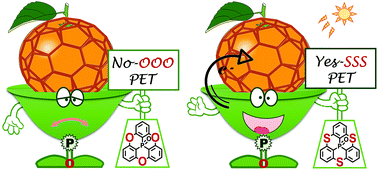
Dalton Trans., 2021,50, 16214-16222
https://doi.org/10.1039/D1DT02034J
DFT insights into the photocatalytic reduction of CO2 to CO by Re(I) complexes: the crucial role of the triethanolamine “magic” sacrificial electron donor
Mechanistic details of the photocatalytic reduction of CO2 to CO catalyzed by the [Re(en)(CO)3Cl] complex in the presence of triethanolamine, R3N (R = CH2CH2OH), in DMF solution were obtained with the aid of DFT computational protocols.

Dalton Trans., 2021,50, 14797-14809
https://doi.org/10.1039/D1DT02188E
A Ru-anthraquinone dyad with triple functions of PACT, photoredox catalysis and PDT upon red light irradiation
A Ru-anthraquinone dyad with triple functions of PACT, photoredox catalysis and PDT upon red light irradiation was reported.
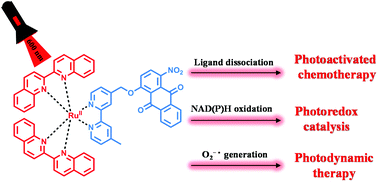
Dalton Trans., 2021,50, 10845-10852
https://doi.org/10.1039/D1DT01088C
Nickel(II) complexes based on dithiolate–polyamine binary ligand systems: crystal structures, hirshfeld surface analysis, theoretical study, and catalytic activity study on photocatalytic hydrogen generation
To ascertain the influence of binary ligand systems on the coordination modes of the Ni(II) metal center and resulting supramolecular architectures, three Ni(II) thiolate complexes have been synthesized in high yield in one step in water and structurally characterized.

Dalton Trans., 2021,50, 5632-5643
https://doi.org/10.1039/D1DT00352F
Photocatalytic hydrogen evolution using a Ru(II)-bound heteroaromatic ligand as a reactive site
A RuII complex with a π-expanded diimine ligand performs photocatalytic H2 evolution and hydrogenation of organic substrates under visible-light irradiation, involving an intermediate with the dihydrogenated ligand; a mechanistic insight into the H2 evolution is also gained.
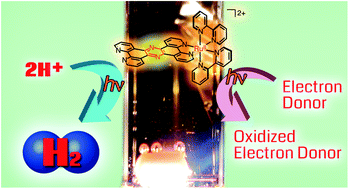
Dalton Trans., 2020,49, 17230-17242
https://doi.org/10.1039/D0DT03546G
Dinuclear uranium(VI) salen coordination compound: an efficient visible-light-active catalyst for selective reduction of CO2 to methanol
The newly synthesized dinuclear uranyl salen coordination compound showed excellent photocatalytic reduction of CO2 to methanol.

Dalton Trans., 2020,49, 17243-17251
https://doi.org/10.1039/D0DT02620D
A theoretical mechanistic study of IrIII/CuI-metallaphotoredox catalyzed asymmetric radical decarboxylative cyanation
The radical mechanism and origin of the high enantioselectivity of the photoredox-mediated IrIII/CuI dual-catalyzed asymmetric decarboxylative cyanation have been theoretically disclosed.
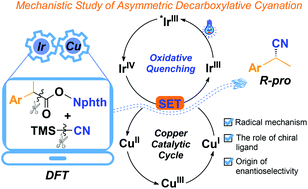
Dalton Trans., 2020,49, 15276-15286
https://doi.org/10.1039/D0DT02630A
A supramolecular bifunctional iridium photoaminocatalyst for the enantioselective alkylation of aldehydes
The construction of a hybrid metal-organo-photoredox catalyst based on the conjugation of an imidazolidinone organocatalyst and Ir(ppy)2(bipy) (ppy = 2-phenylpyridine, bipy = bipyridine) is described.
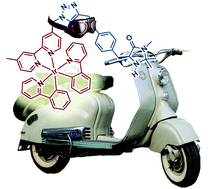
Dalton Trans., 2020,49, 14497-14505
https://doi.org/10.1039/D0DT02587A
New examples of Ru(II)-tetrazolato complexes as thiocyanate-free sensitizers for dye-sensitized solar cells
Newly designed Ru(II) tetrazolato complexes as thiocyanate-free dyes for Ru-based DSSCs.

Dalton Trans., 2020,49, 14543-14555
https://doi.org/10.1039/D0DT02621B
Rational design of type I photosensitizers based on Ru(II) complexes for effective photodynamic therapy under hypoxia
We have developed a series of photosensitizers based on Ru(II) complexes for type I photodynamic therapy to overcome hypoxia.

Dalton Trans., 2020,49, 11192-11200
https://doi.org/10.1039/D0DT01684E
[Re(η6-arene)2]+ as a highly stable ferrocene-like scaffold for ligands and complexes
Sandwich complexes [Re(η6-C6H6)2]+ are versatile scaffolds for conjugating a variety of ligands, as in ferrocene. The high stability of a so-prepared Re/Co system under light irradiation is exemplified with photocatalysis for proton reduction.
![Graphical abstract: [Re(η6-arene)2]+ as a highly stable ferrocene-like scaffold for ligands and complexes](/en/Image/Get?imageInfo.ImageType=GA&imageInfo.ImageIdentifier.ManuscriptID=D0DT00731E&imageInfo.ImageIdentifier.Year=2020)
Dalton Trans., 2020,49, 5250-5256
https://doi.org/10.1039/D0DT00731E
Photocatalytic CO2 reduction using metal complexes in various ionic liquids
Photoreduction of CO2 catalysed by metal complexes successfully took place in various ionic liquids with relatively high durability.
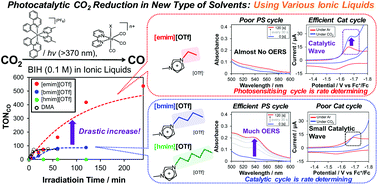
Dalton Trans., 2020,49, 4277-4292
https://doi.org/10.1039/C9DT04689E
Sterically hindered Re- and Mn-CO2 reduction catalysts for solar energy conversion
M(NN)(CO)3X (M = Re, Mn) complexes with a bulky diimine ligand catalyse electrochemical reduction of CO2 with high TON. A noble-metal free system of the Mn-complex photosensitised by a Zn-porphyrin photocatalytically reduces CO2 under visible light.
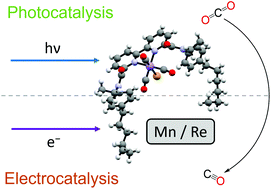
Dalton Trans., 2020,49, 4230-4243
https://doi.org/10.1039/D0DT00252F
About this collection
Many classes of inorganic complexes and materials can participate in photoinduced redox chemistry, in which absorption of a photon generates an excited state that then undergoes an electron-transfer event with a redox partner. Many classes of inorganic compounds spanning a large portion of the periodic table, including transition metal and f-element coordination compounds, organometallic complexes, MOFs, nanomaterials, and extended inorganic solids, can undergo photoinduced redox chemistry. Fundamental studies of the thermodynamics and kinetics of these excited-state redox processes remain important, as they continue to reveal key insights into how ligand design, electron configuration, molecular structure, crystal structure, environment and composition affect the excited-state redox chemistry of these many categories of inorganic compounds. Moreover, photoinduced charge transport processes involving inorganic compounds are important elementary steps in several applications, including but not limited to solar fuels, organic photoredox catalysis, dye-sensitized solar cells, and photodynamic therapy.
This Spotlight Collection covers various aspects of photoinduced redox chemistry in inorganic compounds including excited-state redox processes involving new inorganic materials, the development of novel systems for studying and optimizing these processes, and studies using known compounds for applications related to photoinduced charge transport, highlighting the important roles that existing inorganic compounds can play in these areas. This collection will showcase the combined roles that synthetic and physical inorganic chemistry, including time-resolved spectroscopy and computational studies, play in driving fundamental and applied research in this continually evolving field of research.
This collection is guest edited by Dalton Transactions Advisory Board member Prof. Thomas Teets (University of Houston), Prof. Dr. Katja Heinze (Johannes Gutenberg University Mainz) and Prof. Paul Elliott (University of Huddersfield).
Articles will be added to this themed collection as soon as possible after they are published. Please return to this page frequently to see the collection grow.
If you would like to contribute an article to this collection, please contact the Editorial Office at dalton-rsc@rsc.org with your proposed topic.